Abstract
Typically, cavities of sub-terahertz electron cyclotron masers (gyrotrons) have oversized dimensions. That leads to a problem of the dense mode spectrum and, as a result, to a problem of the mode selectivity in the process of realization of gyrotrons operating at high cyclotron harmonics. Open (mirror) type systems have a much sparser mode spectrum than closed-type systems. We suggest a way to further reduce the mode spectrum by implementing a cavity based on a photonic structure formed by two parallel corrugated mirrors, which are considerably offset from being in front of each other so that no mode can be supported by mirror reflection from them. The operating mode is contained by backward reflection from the corrugated mirrors based on the (−1)st order diffraction mechanism. The proposed system has intrinsic dispersion compensation properties which make it usable in a wide (~20%) frequency band. Simulated characteristics of a 2D prototype are presented and possible application for a gyrotron operating at a harmonic of the cyclotron frequency is discussed.
1. Introduction
Gyrotrons are the most powerful sources of coherent radiation based on cyclotron excitation of the high-Q near-cutoff mode of open cavities by a beam of electrons rotating in the strong axial magnetic fields []. Since the frequency of a traditional fundamental-cyclotron-harmonic gyrotron is close to the electron cyclotron frequency, the advancement of such devices to the terahertz frequencies is limited by the attainable magnetic fields. A natural solution to this problem is the operation of cyclotron harmonics. In recent years, subterahertz gyrotrons operating at 2nd and 3rd harmonics of gyro-frequency have been demonstrated to extend the gyrotron frequency range otherwise limited by the maximum value of the magnetic field [,,,,,,,,,]. The interest in such sources based on electron cyclotron radiation is motivated by their relatively high power that makes them suitable for spectroscopic applications [,,,,,,,].
One of the most important problems of high-harmonic gyrotrons is that an increase in the operating cyclotron harmonic number leads to a dramatic decrease in the electron–wave coupling and, as a result, to a strong competition from the parasitic waves excited at lower harmonics. This problem is especially severe in the sub-THz frequency range, where the use of highly oversized cavities is inevitable and the mode spectrum is dense.
Figure 1a illustrates a typical schematic of the gyrotron. A beam of electrons rotating in the magnetic field excites a near-cutoff TE wave of a regular operating cavity. The output wave goes out from the cavity through a horn section (where the near-cutoff operating wave is transformed into a traveling wave). A wave converter placed outside of the operating cavity transforms the operating wave with a complicated transverse field structure (typically it corresponds to a relatively high-order TE mode) into the output wave beam that leaves the system through the side window. The most classical gyrotron scheme is based on the use of a regular cavity with a circular cross-section (Figure 1b). Such a cavity supports a set of transverse modes with different azimuthal and radial wave indices (mr and mφ). Let us consider the situation where the electron-wave resonance takes place for a high-order near-cutoff TE mode at cyclotron harmonic ,
Here, is the operating frequency, and is the relativistic electron cyclotron frequency. Figure 1e illustrates the case where . Evidently, one can find a number of parasitic waves (lower TE modes) with frequencies which can be excited either due to the gyrotron-type resonance (points “gyro” in Figure 1e)
or due to the backward-wave-oscillator resonance (points “BWO” in Figure 1e)
Here, is the axial electron velocity, and is the axial wavenumber ( corresponds to the BWO-type resonance). All these waves are in resonance with the electron beam, a feedback is provided for these parasitic waves due to their either near-cutoff or BWO-type properties, and they interact with the electron beam more strongly than the operating wave excited at a higher cyclotron harmonic, .
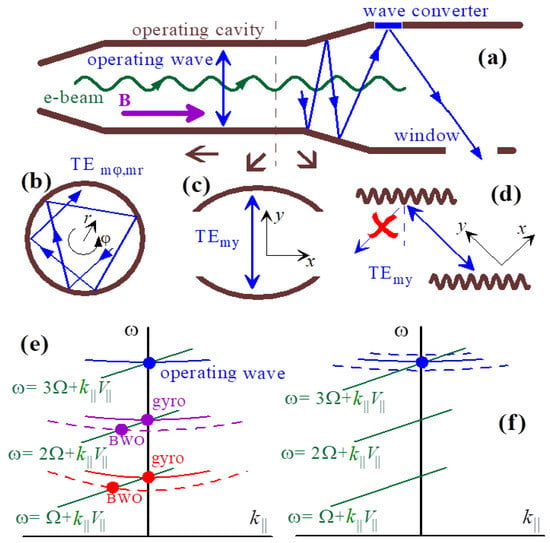
Figure 1.
(a) Schematic of a gyrotron. (b) Circular cross-section of the conventional gyrotron cavity. (c) Cross-section of the open (in one of the transverse directions) quasi-planar cavity. (d) Cross-section of the photonic-structure cavity proposed in this paper. (e) Dispersion characteristic of different transverse modes in the conventional cavity, gyrotron-type excitation of the high-harmonic (N=3 in this example) operating wave, gytoron-type and BWO-type excitation of the lower-harmonic parasitic waves. (f) Dispersion characteristic of transverse modes in the photonic-structure cavity proposed in this paper.
Thus, the implementation of terahertz high-harmonic gyrotrons requires special methods to increase the mode selectivity. The obvious approach along this way is to exploit the electrodynamic selection methods associated with the use of cavities of complicated shapes. One can mention here gyrotrons with irregular (in the axial direction) cavities (including systems of coupled cavities [,,,], echelette systems [,,], as well as cavities with short selective elements [,,]), as well as cavities with complicated transverse cross-sections [,,]. Typically, such approaches help to suppress gyrotron-type parasitic waves, while the fight against the BWO-type parasitic wave remains an unsolved problem [].
An approach based on the use of open planar and quasi-planar cavities (Figure 1c) is currently considered very promising [,,,,]. First of all, due to the openness in one of the transverse directions (in the x direction in Figure 1c), such a cavity has a much more sparse spectrum of its transverse eigenmodes. Actually, in this case, high-Q transverse modes are characterized by only one index my. Naturally, this greatly facilitates the problem of mode selectivity, although it does not completely solve it. At the same time, the advantage of this system is the possibility of implementing a smooth mechanical adjustment of the frequency of the operating mode by changing the distance between the mirrors forming the operating cavity. This possibility is very attractive from the point of view of creating gyrotrons for spectroscopic applications.
In this paper, we develop this “quasi-planar” approach. We propose to use a “photonic structure” consisting of two parallel corrugated mirrors acting as two diffraction gratings (Figure 1d). The corrugation period and amplitude of each of these two mirrors is chosen to provide the total reflection of a wave incident at an angle to the surface back in the same direction (in the direction of the wave incidence).
Naturally, this is possible only within a relatively narrow frequency band where the corresponding Bragg-type resonance is provided. As a result, such a system supports only high-Q transverse modes with cutoff frequencies placed in a narrow band (Figure 1f). From the point of view of the problem of suppression of parasitic waves excited at lower cyclotron harmonics, this system can be called “single-frequency”, because this system does not allow transverse modes in the frequency ranges corresponding to parasitic modes. At the same time, this system is relatively broadband around the design frequency. Therefore, it is robust to many imperfections that should make it easy to assemble the cavity and to obtain a good quality factor of the operating mode.
In this paper, a 2D quantitative model of a 250 GHz cavity has been developed and simulated. The use of this 2D model is explained by the peculiarity of short-wave gyrotrons operating at high cyclotron harmonics, that, as a rule, large lengths (dozens of wavelengths) of operating cavities are required for their excitation due to the weakness of the electron–wave interaction [,,,,]. As a result, from a purely electrodynamic point of view, the operating cavity can be considered infinitely long in the longitudinal (axial) direction. Indeed, the corresponding component of the wavenumber of the lowest axial mode of such a cavity (the operating wave of the gyrotron) is close to zero. Accordingly, the losses associated with the output of radiation in the axial direction are usually small against the background of “transverse” losses (these are Ohmic losses in the walls of the cavity and, in our case, also diffraction losses associated with the opening of the cavity in one of the transverse directions). In addition, in this paper, we describe a possible system of the output of the wave power from such a cavity, as well as give some estimates for starting currents of high-harmonic gyrotrons based on this cavity.
2. Design of the Cavity and Q-Factors of Possible Parasitic Waves
The proposed cavity in its 2D version and the corresponding eigenmode are shown in Figure 2. Two parallel gratings reflect waves incident at 45 degrees backward (Littrow configuration; see, e.g., []), thus confining a standing mode the existence of which is not possible when the mirrors are not corrugated. At the same time as the mirrors are highly offset from being in front of each other, there are no modes supported by mirror reflection.
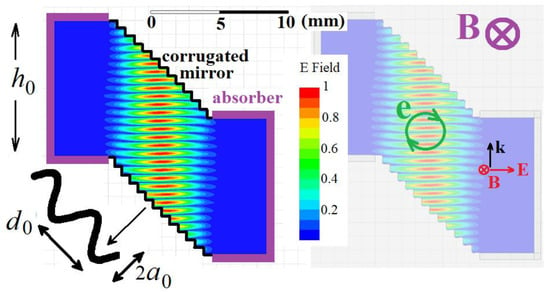
Figure 2.
Eigenmode in the form of a standing wave confined by two metal diffraction gratings. The image is taken from HFSS. The electric field vector belongs to the picture plane, its absolute value is depicted by color. The “[” and “]”-shape areas are matched absorbers used to restrict the simulation area. The right picture illustrates cyclotron orbit of electrons on the background of the transverse cross-section of the gyrotron cavity, as well as orientation of electric and magnetic field in one of two traveling components forming the standing eigenwave. The color scale is in arbitrary units.
The corrugation period and depth are wavelength specific. In our situation, the corrugation period is chosen so that the gratings can reflect the wave only in the “zero” (mirror-like) and in the (−1)st diffraction direction. In this case, at any type of shape of the corrugation one can find the “proper” corrugation depth, when gratings reflect almost the whole wave power in the (−1)st diffraction direction (Figure 1d). A saw-tooth-like corrugation and a sinusoidal corrugation are the most popular choices with the sinusoidal corrugation being able to sustain higher powers due to the absence of sharp corners. Therefore, we use a sinusoidal corrugation.
In simulations, the cavity formed by two corrugated mirrors was surrounded at open sides by a rectangular absorber (perfectly matched layers); the absorption of the wave beams coming out from the cavity in these layers corresponded to the diffraction loss in this cavity. To compensate for the wave beam spreading in between the gratings and thus to reduce the diffraction loss due to the finite transverse sizes of the grating mirrors a quadratic shape component has been added to the profile of the mirrors. The focusing strength has been tuned numerically for the minimum diffraction loss in computations. The cavity was aimed for the eigenfrequency of about 250 GHz, and the corresponding grating amplitude (half depth) and period were chosen: 0.172 mm and 0.849 mm. The grating length was chosen to be 12.5 corrugation periods. A higher number of periods makes the mode wider and thus reduces its coupling coefficient to the electron beam. Too few periods will make the mode too narrow, so it will be scattered apart as a result of diffraction on the small number of grooves. The distance between the grating centers was chosen to be 10 mm. Bigger distances are unfavorable due to the reduction in coupling with the electron beam and shorter distances are unfavorable due to the appearance of modes formed by mirror reflection because of the gratings overlap.
In fact, the “photonic structure” proposed in this work represents a cavity supporting near-cutoff transverse modes whose frequencies lie in the narrow band of the Bragg resonance of this structure:
Here, is the wavenumber corresponding to the operating frequency 250 GHz, and is the component of the total wavenumber parallel to the corrugated mirror. According to simulations (see Section 3), the Q-factor of the operating transverse mode shown in Figure 2 describing losses of this wave in the open transverse direction together with Ohmic losses in mirrors can be as high as several thousands.
Modes with other frequencies can exist only due to operating this system as an ordinary Fabry–Perot cavity. Figure 3 illustrates operating such a cavity at three frequencies, namely, at a frequency close to the target one ( 250 GHz), as well as near the 2nd sub-harmonic and the 3rd sub-harmonic ( and , respectively). The latter two cases correspond to the excitation of the parasitic waves at the fundamental cyclotron resonance in 250 GHz gyrotrons operating at the second and third cyclotron harmonics, respectively. In all these three cases, the Q-factors of parasitic modes are very small (more specifically, two orders of magnitude lower than the Q-factor of the operating wave). Thus, we can state that the system shown in Figure 2 supports high-Q transverse modes only in a relatively narrow frequency range close to (this fact is illustrated schematically in Figure 1f). More detailed calculations of the properties of these eigenmodes are given in the next Section 3.

Figure 3.
Modes corresponding to ordinary Fabry–Perot resonance near the target frequency, as well as near the 2nd subharmonic and the 3rd subharmonic. The Q-factor is low due to a small overlap of the mode field radiation by the mirrors. The color scale is in arbitrary units.
3. Operating Transverse Modes
In the system of two parallel gratings reflecting waves in the (−1)st diffraction direction, instead of increasing any angle deflection produced at the first grating by a frequency deviation the second grating fully compensates for it. As a result of this angular dispersion compensation reached after a full pass of the cavity by the wave beam, such a system possesses intrinsically broadband properties. That makes possible the existence of other high-Q eigenmodes different from the design mode by the number of field variations between the gratings and the angle of incidence to the grating (Figure 4). The frequency interval between them is as bigger as the distance between the gratings is smaller. In the case of the transverse sizes of the system mentioned above, this frequency interval is close to 14 GHz.
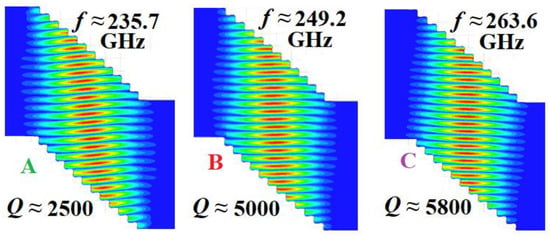
Figure 4.
Eigenmodes with different numbers of field variations between the corrugated mirrors and their Q-factors in the case of the distance between the corrugated mirrors h = h0 = 10 mm. The modes A, B, and C are described by curves A, B, and C in Figure 5.
In the HFSS simulations presented in this paper, we calculate the diffraction losses of different eigenmodes that are caused by the openness of the system in one of the transverse directions. In addition, on the basis of auxiliary 2D CST simulations, we take into account also the Ohmic losses in both corrugated mirrors. In these simulations, the metal conductivity is assumed to be 1.4E7 S/m (four times smaller than the conductivity of the ideal cooper); this is a traditional approach used to take into account imperfection (roughness) of the walls of cavities of short-wavelength gyrotrons. As a result, we obtain the Q-factors of eigenmodes describing the total losses of their power.
As a result of these calculations, Figure 5 illustrates eigenfrequencies and the Q-factors of different modes of this system at different distances h between the corrugated mirrors. Here, the extreme left points on curves A, B, and C (describing Q-factors and frequencies of eigenmodes in the case of h = h0 = 10 mm) correspond to the modes A, B, and C in Figure 4. At any fixed distance h between the mirrors, we see a set of different modes spaced relative to each other by a frequency close to 14 GHz. They have different Q-factors, and at any fixed distance h only three of them have relatively high Q-factors. For instance, at h = h0 these are modes B, C, and D (their Q-factors vary from 4500 up to 5500), whereas the Q-factor of mode A shown in Figure 4 is significantly lower (2500). However, if we increase the distance up to h = h0 + 0.6 mm (the extreme right points on different curves), then the “main” modes are A, B, and C, whereas the Q-factor of mode D is less than 3000.
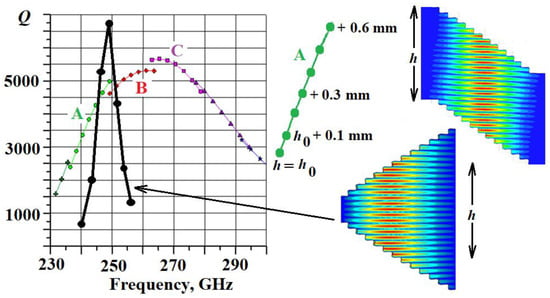
Figure 5.
Mode Q-factor versus frequency. Different curves correspond to modes with different numbers of longitudinal field variations. Different points on the same curve correspond to different distances between the gratings h for the same mode with a fixed number of field variations. The distance between the gratings changes from h0 = 10 mm up to h0 + 0.6 mm with a step of 0.1 mm. Curves A, B, and C correspond to the modes A, B, and C in Figure 4. For comparison, the echelette cavity with the same gratings and the same average distance between the gratings has only one longitudinal mode, and its sharp dependence on the inter-grating distance is demonstrated with a black curve.
According to Figure 5, this system is extremely uncritical to the error in the distance between the mirrors. Actually, even if the distance h changes by 1 mm (that is, by 10%), there are still several high-Q modes in this system. At the same time, if there is a possibility for changing the distance between the gratings, then it is possible to continuously tune the frequency of the eigenmodes in a wide band, namely, modes with Q-factors over 3000 exist in the band 240–290 GHz (the relative frequency band is close to 25%).
Figure 5 illustrates also the advantages of the system proposed in this paper as compared to the echelette system. The echelette cavity with the same gratings and the same average distance between the gratings has only one longitudinal mode, and this mode possesses a sharp dependence of the Q-factor on the inter-grating distance.
Figure 6 illustrates the sensitivity of the Q-factor of the cavity to changes in the corrugation period. This is also significantly lower than in the case of a cavity with the echelette-type transverse cross-section.
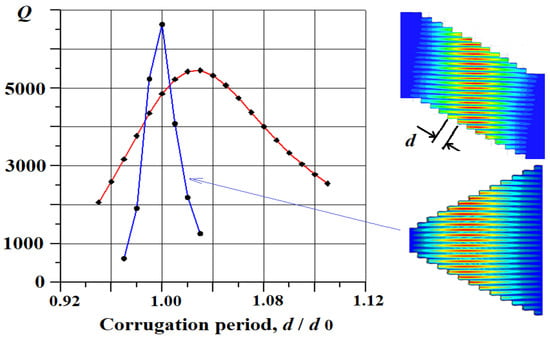
Figure 6.
Mode Q-factors of the echelette-type cavity (blue curve) and the cavity formed by two parallel gratings (red curve) as functions of corrugation period with the number of corrugation grooves staying unchanged.
If we increase twice both transverse sizes of the system (the distance between the mirrors h and the length of the corrugated mirrors) at the fixed operating frequency (fixed parameters of the corrugation), then the Q-factor decreases by a factor of 2 (Figure 7a). At the same time, the use of corrugated mirrors having a parabolic form (instead of planar mirrors) can increase the Q-factor by the order of magnitude due to the focusing properties of such mirrors (Figure 7b). One more advantage of such a focusing system is reducing the effective transverse size of the wave beam inside the cavity. As a result, this effect increases the factor of coupling between the cavity eigenmode and the operating electron beam of a gyrotron realized on the basis of such a cavity (see Section 5).
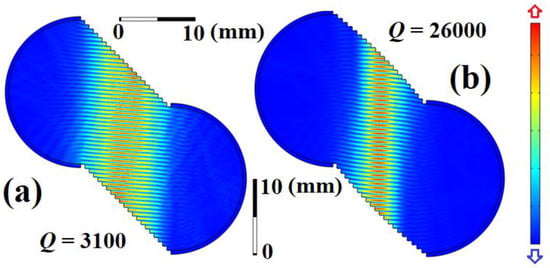
Figure 7.
Transverse cross-sections of cavities with the distance between mirrors h = 20 mm. (a) Planar corrugated mirrors. (b) Optimized parabolic corrugated mirrors. Corresponding values of Q-factors of the modes are also shown.
4. Wave Output System
If the corrugation depth is different from its optimized value, there will be a wave reflected from the grating in the mirror direction and thus the cavity quality factor will be reduced. According to simulations, if the corrugation depth is reduced or increased by 5% the imaginary part of the eigenfrequencies changes from 0.0256 GHz to 0.0358 GHz or 0.0327 GHz correspondingly.
In reality, the cavity will always have a finite size along the grooves direction and the energy output will need to be implemented. The most practical way to organize the energy output from the cavity is by using a reflected beam from one of the gratings. To do so, it is sufficient to reduce the depth of the corrugation in the downstream section of the gyrotron electrodynamic system (Figure 8a). In the example shown in Figure 8, the corrugation depth of the upper grating in the wider output section is decreased. As a result, the piece of the cavity formed by two mirrors with a not deep enough upper grating radiates a traveling wave in the left direction. According to simulations, the reflected output wave beam formed in such a wave possesses a clearly expressed spot on the center of its cross-section (Figure 8d).
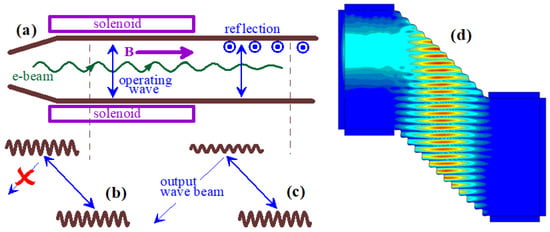
Figure 8.
(a) Schematic of the gyrotron with the wave output system. (b) Transverse cross-section of the operating cavity. (c) Transverse cross-section of the system of formation of the output wave beam. (d) Simulations of the planar system of formation of the output wave beam, where a not deep enough upper grating radiates a traveling wave in the left direction.
Naturally, in the purely transverse 2D simulations we cannot model the “total” cavity (Figure 8a), which is irregular along the axial coordinate, as it consists of the operating sections (Figure 8b) and the output section (Figure 8b). Figure 8d illustrates just 2D simulations of a cavity formed by two mirrors with different corrugation amplitudes. In order to simulate the output system in more detail, 3D simulations taking into account a region of the transition from the operating sections into the output section are required. In addition, it is desirable to change the grooves of the corrugation in such a way that the output radiation takes the form of a Gaussian beam in both directions of its transverse cross-section, including the seconds, and axial direction of the gyrotron system. In order to form the proper shape of the output wave beam in the second direction, the change in the corrugation should be monotonically increasing towards the end of the gyrotron electrodynamic system.
5. Estimations for Starting Currents of High-Cyclotron-Harmonic Gyrotrons
The starting current of high-harmonic gyrotron based on the photonic-structure microwave system described above can be found on the basis of the asymptotic theory, which is valid for gyrotrons with weak electron–wave interaction [,,]. This theory is based on the equation for the relativistic electron energy for a near-cutoff TE transverse mode of the operating cavity:
Here, is the axial electron velocity, and describes the transverse oscillations of electrons in the operating magnetic field. We consider a wave structure, which is similar to the wave structure inside a Fabry–Perot cavity (Figure 9). We assume that in the region close to the electron beam the electric field of the wave has only the x component and varies only along the y coordinate:
Here, we have assumed that the y component of the wavenumber approximately coincides with the total wavenumber, . Therefore, in Equation (5) .
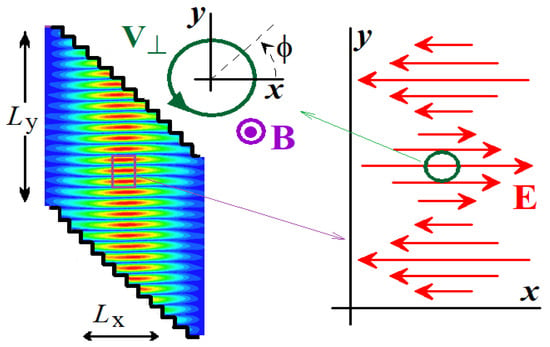
Figure 9.
Illustration of the mechanism of the electron–wave interaction.
The transverse coordinates of electrons and the x component of the electron velocity are described as follows:
Here, is the point of the center of the electron orbit, is the gyro-rotation phase, and is the gyro-radius. Thus, Equation (5) is re-written as follows:
Here, are the normalized component of the electron velocity, and is determined by the transverse electron velocity and the operating cyclotron harmonic number .
As the next step, one should represent the function in the form of the Fourier series,
and keep the only resonant term in this sum. Typically, the gyro-radius is much smaller than the wavelength (Figure 9) and, therefore, . In this situation, the absolute value of is easily found by decomposing the function F into a Taylor series with respect to a small parameter :
Thus, Equation (8) is represented in the following form:
Here, is the resonant phase of a particle with respect to the wave which is described by the following equation:
Here, is the non-relativistic cyclotron frequency, and is the initial electron momentum. According to the asymptotic theory [,,], in the limit of a small wave amplitude Equations (11) and (12) predict the following averaged (over all electron gyro-phases ) change in the electron energy:
Here, is the normalized efficiency found in the small-signal theory, is the length of the operating cavity along the z-direction. At the same time, the change in electron energy should satisfy the equation describing the power balance in the “electron beam-cavity wave” system,
Here, I is the electron current, Q is the total Q-factor, and the wave energy stored inside the cavity is described as follows:
Here, and are the effective transverse sized of the wave field (Figure 9).
As a result, Equations (13)–(15) to the following estimation for the starting current of a gyrotron based on the photonic structure described above:
Here, = 17 kA, and is the effective cross-section area of the cavity occupied by the wave field.
It is natural to assume that a long cavity is required to provide the start of oscillations due to a weak electron–wave interaction at a high cyclotron harmonic. In this situation, the Q-factor of the cavity is determined mainly by the Q-factor 5000 describing the diffraction loss of the wave power in transverse directions of the cavity cross-section together with Ohmic losses (see Figure 5 and Figure 6).
If we consider an 80 kV/1A gyrotron with an axis-encircling electron beam with a pitch factor of electrons equal to 1.3 [,], then the excitation of the 250 GHz wave at the second cyclotron harmonic requires a cavity with a length of 20 mm (17 wavelengths). In the case of the operation at the third cyclotron harmonic, the cavity should be as long as 50 mm (about 40 wavelengths). Note that the only problem arising due to so long cavities is a great share of losses of the power radiated by electrons. At the same time, long lengths do not result to appearing the problem of competition of the operating high-harmonic wave with the lower-frequency fundamental-harmonic parasitic waves.
Note that the estimations given above are obtained for Q-factors of cavities formed by planar corrugated mirrors. At the same time, the use of focusing mirrors with the parabolic geometry (Figure 7b) increases the Q-factor by an order of magnitude, as well as decreases the effective cross-section area of the cavity occupied by the wave field approximately by a factor of 2. According to Equation (5), these two effects should decrease the starting lengths of high-harmonic gyrotrons by a factor of 4-5 as compared to the estimations given above.
6. Discussion
Naturally, this paper presents only a very schematic concept of a high-cyclotron-harmonic gyrotron based on the selective diffraction grating cavity described above. We show that at least in the sub-THz frequency range such a system can be realized on the bases of existing high-harmonic gyrotron installations. The advantages are the frequency selectivity of such a cavity (as it supports high-Q near-cutoff eigenmodes only in a relatively narrow frequency band), a relatively weak sensitivity to the manufacturing errors and to the corrugation parameters, as well as a possibility for realization of a broadband continuous frequency tuning in such a gyrotron be means of mechanical changing the distance between the two corrugated mirrors. In addition, quite an elegant system of formation of the output wave beam can be realized.
At the same time, a lot of problems are out of consideration in this paper. First of all, a more detailed theory of the electron–wave interaction in a gyrotron based on the photonic-structure cavity should be developed. This theory should include consideration of various configurations (axis-encircling, tubular, multi-beam) of operating electron beams, an analysis of the non-linear steady-state regime of the gyrotron generation, as well as an analysis of the interaction of electrons with different transverse modes with close frequencies presented in this system. Naturally, more detailed 3D optimization of elements of the electrodynamic system (including the wave output system with corrugation parameters profiled in the axial direction) is required.
One more problem is the possibility of manufacturing such systems. The 250 GHz system presented in this paper looks quite realistic (at least at first glance). At the same time, an increase in the operating frequency should lead to a proportional decrease in the size of the corrugation. Possibly, the use of methods based on novel additive technology of metallization of 3D-printed photopolymer-based structures [] can be a way to solve this problem at least for low-power (with output power at the level of Watts or tens of Watts) gyrotrons developed for spectroscopy applications.
Author Contributions
Conceptualization, A.S. and D.S.; methodology, A.S. and D.S.; software, D.S.; validation, A.S. and D.S.; formal analysis, A.S.; investigation, A.S. and D.S.; writing—original draft preparation, A.S. and D.S.; writing—review and editing, A.S. and D.S.; supervision, A.S. All authors have read and agreed to the published version of the manuscript.
Funding
This work was supported by the Russian Science Foundation, grant No. 20–72–10116.
Institutional Review Board Statement
Not applicable.
Informed Consent Statement
Not applicable.
Data Availability Statement
Not applicable.
Conflicts of Interest
The authors declare no conflict of interest.
References
- Nusinovich, G.S. Introduction to the Physics of Gyrotrons; John Hopkins Univ. Press: Baltimore, MD, USA, 2004. [Google Scholar]
- Hornstein, M.K.; Bajaj, V.S.; Griffin, R.G.; Temkin, R.J. Continuous-wave operation of a 460-GHz second harmonic gyrotron oscillator. IEEE Trans. Plasma Sci. 2006, 34, 524–533. [Google Scholar] [CrossRef] [PubMed]
- Bratman, V.L.; Bandurkin, I.V.; Dumesh, B.S.; Fedotov, A.E.; Kalynov, Y.K.; Kolganov, N.G.; Manuilov, V.N.; Rusin, F.S.; Samsonov, S.V.; Savilov, A.V. Sources of coherent terahertz radiation. In AIP Conference Proceedings; American Institute of Physics: College Park, MA, USA, 2006; Volume 807, pp. 356–366. [Google Scholar]
- Bratman, V.L.; Kalynov, Y.K.; Manuilov, V.N. Large-orbit gyrotron operation in the terahertz frequency range. Phys. Rev. Lett. 2009, 102, 245101. [Google Scholar] [CrossRef] [PubMed]
- Notake, T.; Saito, T.; Tatematsu, Y.; Fujii, A.; Ogasawara, S.; Agusu, L.; Ogawa, I.; Idehara, T.; Manuilov, V.N. Development of a novel high power sub-THz second harmonic gyrotron. Phys. Rev. Lett. 2009, 103, 225002. [Google Scholar] [CrossRef] [PubMed]
- Torrezan, A.C.; Shapiro, M.A.; Sirigiri, J.R.; Temkin, R.J.; Griffin, R.G. Operation of a continuously frequency-tunable secondharmonic CW 330-GHz gyrotron for dynamic nuclear polarization. IEEE Trans. Electron Dev. 2011, 58, 2777–2783. [Google Scholar] [CrossRef]
- Temkin, R.J. Development of terahertz gyrotrons for spectroscopy at MIT. THz Sci. Technol. 2014, 7, 1–9. [Google Scholar]
- Glyavin, M.Y.; Idehara, T.; Sabchevski, S.P. Development of THz gyrotrons at IAP RAS and FIR UF and their applications in physical research and high-power THz technologies. IEEE Trans. Terahertz Sci. Technol. 2015, 5, 788–797. [Google Scholar] [CrossRef]
- Bandurkin, I.V.; Bratman, V.L.; Kalynov, Y.K.; Osharin, I.V.; Savilov, A.V. Terahertz large-orbit high-harmonic gyrotrons at IAP RAS: Recent experiments and new designs. IEEE Trans. Electron Dev. 2018, 65, 2287–2293. [Google Scholar] [CrossRef]
- Kalynov, Y.K.; Manuilov, V.N.; Fiks, A.S.; Zavolskiy, N.A. Powerful continuous-wave sub-terahertz electron maser operating at the 3rd cyclotron harmonic. Appl. Phys. Lett. 2019, 114, 213502. [Google Scholar] [CrossRef]
- Bandurkin, I.V.; Fokin, A.P.; Glyavin, M.Y.; Luchinin, A.G.; Osharin, I.V.; Savilov, A.V. Demonstration of a selective oversized cavity in a terahertz second-harmonic gyrotron. IEEE Electron Device Lett. 2020, 41, 1412–1415. [Google Scholar] [CrossRef]
- Nanni, E.A.; Barnes, A.B.; Griffin, R.G.; Temkin, R.J. THz dynamic nuclear polarization NMR. IEEE Trans. Terahertz Sci. Technol. 2011, 1, 145–163. [Google Scholar] [CrossRef]
- Golubiatnikov, G.Y.; Koshelev, M.A.; Tsvetkov, A.I.; Fokin, A.P.; Glyavin, M.Y.; Tretyakov, M.Y. Sub-Terahertz High-Sensitivity HighResolution Molecular Spectroscopy with a Gyrotron. IEEE Trans. Terahertz Sci. Technol. 2020, 10, 502–512. [Google Scholar] [CrossRef]
- Denysenkov, V.; Prandolini, M.J.; Gafurov, M.; Sezer, D.; Endeward, B.; Prisner, T.F. Liquid state DNP using a 260 GHz high power gyrotron. Phys. Chem. Chem. Phys. 2010, 12, 5786–5790. [Google Scholar] [CrossRef] [PubMed]
- Glyavin, M.; Denisov, G.; Zapevalov, V.; Koshelev, M.; Tretyakov, M.; Tsvetkov, A. High-power terahertz sources for spectroscopy and material diagnostics. Phys.-Uspekhi 2016, 59, 595. [Google Scholar] [CrossRef]
- Koshelev, M.A.; Tsvetkov, A.I.; Morozkin, M.V.; Glyavin, M.Y.; Tretyakov, M.Y. Molecular gas spectroscopy using radioacoustic detection and high-power coherent subterahertz radiation sources. J. Mol. Spectrosc. 2017, 331, 9–16. [Google Scholar] [CrossRef]
- Vondracek, H.; Dielmann-Gessner, J.; Lubitz, W.; Knipp, M.; Havenith, M. THz absorption spectroscopy of solvated innodatabeta β-lactoglobulin. J. Chem. Phys. 2014, 141, 22D534. [Google Scholar] [CrossRef] [PubMed]
- Miyamoto, K.; Yamasaki, T.; Tsuji, S.; Inoue, K.; Park, G.; Uchida, H.; Matsuura, A.; Krüger, P.; Omatsu, T. Ultrawideband and High-Resolution Terahertz Spectroscopy: Structural Identification of Glucose. Photonics 2022, 9, 602. [Google Scholar] [CrossRef]
- Zhang, Y.; Miao, T.; Mu, Q.; Zhou, L.; Meng, C.; Xue, J.; Yao, Y. A Novel High-Sensitivity Terahertz Microstructure Fiber Biosensor for Detecting Cancer Cells. Photonics 2022, 9, 639. [Google Scholar] [CrossRef]
- Zapevalov, V.E.; Malygin, S.A.; Pavel’ev, V.G.; Tsimring, S.E. Coupled-resonator gyrotrons with mode conversion. Radiophys. Quantum Electron. 1984, 27, 846–852. [Google Scholar] [CrossRef]
- Pavel’ev, V.G.; Tsimring, S.E.; Zapevalov, V.E. Coupled cavities with mode conversion in gyrotrons. Int. J. Electron. 1987, 63, 379–391. [Google Scholar] [CrossRef]
- Savilov, A.V. High-harmonic gyrotron with sectioned cavity. Appl. Phys. Lett. 2009, 95, 073503. [Google Scholar] [CrossRef]
- Bandurkin, I.V.; Kalynov, Y.K.; Makhalov, P.B.; Osharin, I.V.; Savilov, A.V.; Zheleznov, I.V. Simulations of sectioned cavity for high-harmonic gyrotron. IEEE Trans. Electron Dev. 2017, 64, 300–305. [Google Scholar] [CrossRef]
- Vlasov, S.N.; Koposova, E.V.; Pavel’ev, V.G.; Khizhnyak, V.I. Gyrotrons with echelette resonators. Radiophys. Quantum Electron. 1996, 39, 458–462. [Google Scholar] [CrossRef]
- Belousov, V.I.; Vlasov, S.N.; Zavolskiy, N.A.; Zapevalov, V.E.; Koposova, E.V.; Kornishin, S.Y.; Kuftin, A.N.; Moiseev, M.A.; Khizhnyak, V.I. Studies of a gyrotron with the echelette cavity. Radiophys. Quantum Electron. 2014, 57, 446–454. [Google Scholar] [CrossRef]
- Zapevalov, V.E.; Vlasov, S.N.; Koposova, E.V.; Kuftin, A.N.; Pavel’ev, V.G.; Zavolskiy, N.A. Various types of echelette resonators for gyrotrons. In EPJ Web of Conferences, Proceedings of the 3rd International Conference “Terahertz and Microwave Radiation: Generation, Detection and Applications” (TERA-2018), Novgorod, Russia, 22–25 October 2018; EDP Sciences: Les Ulis, France, 2018; Volume 195, p. 01022. [Google Scholar] [CrossRef]
- Kalynov, Y.K.; Osharin, I.V.; Savilov, A.V. A method for suppression of spurious fundamental-harmonic waves in gyrotrons operating at the second cyclotron harmonic. Phys. Plasmas 2016, 23, 053116. [Google Scholar] [CrossRef]
- Kalynov, Y.K.; Osharin, I.V.; Savilov, A.V.; Zavolsky, N.A. Relativistic Second-Harmonic Gyrotron with a Selective Quasi-Regular Cavity. IEEE Trans. Electron Dev. 2016, 63, 4968–4974. [Google Scholar] [CrossRef]
- Bandurkin, I.V.; Glyavin, M.Y.; Kuzikov, S.V.; Makhalov, P.B.; Osharin, I.V.; Savilov, A.V. Method of providing the high cyclotron harmonic operation selectivity in a gyrotron with a spatially developed operating mode. IEEE Trans. Electron Dev. 2017, 64, 3893–3897. [Google Scholar] [CrossRef]
- Shcherbinin, V.I.; Tkachenko, V.I. Cylindrical cavity with distributed longitudinal corrugations for second-harmonic gyrotrons. J. Infr. Millim. Terahertz Waves 2017, 38, 838–852. [Google Scholar] [CrossRef]
- Tkachova, T.I.; Shcherbinin, V.I.; Tkachenko, V.I. Selectivity properties of cylindrical waveguides with longitudinal wall corrugations for second-harmonic gyrotrons. J. Infr. Millim. Terahertz Waves 2019, 40, 1021–1034. [Google Scholar] [CrossRef]
- Bandurkin, I.V.; Kalynova, G.I.; Kalynov, Y.K.; Osharin, I.V.; Savilov, A.V.; Shchegolkov, D.Y. Mode Selective Azimuthally Asymmetric Cavity for Terahertz Gyrotrons. IEEE Trans. Electron Dev. 2021, 68, 347–352. [Google Scholar] [CrossRef]
- Kalynov, Y.K.; Savilov, A.V.; Semenov, E.S. Parasitic excitation of fundamental-cyclotron-harmonic waves in high-harmonic gyrotrons. Phys. Plasmas 2021, 28, 113105. [Google Scholar] [CrossRef]
- Ginzburg, N.S.; Zotova, I.V.; Sergeev, A.S.; Zaslavsky, V.Y.; Zheleznov, I.V. High-Power Terahertz-Range Planar Gyrotrons with Transverse Energy Extraction. Phys. Rev. Lett. 2012, 108, 105101. [Google Scholar] [CrossRef] [PubMed]
- Bratman, V.L.; Kalynov, Y.K.; Kalynova, G.I.; Manuilov, V.N.; Makhalov, P.B. Frequency tuning in a subterahertz gyrotron with a variable cavity. IEEE Trans. Electron Dev. 2014, 61, 3529–3533. [Google Scholar] [CrossRef]
- Nusinovich, G.S. To the theory of gyrotrons with confocal resonators. Phys. Plasmas 2019, 26, 053107. [Google Scholar] [CrossRef]
- Guan, X.; Zhang, J.; Fu, W.; Lu, D.; Yang, T.; Yan, Y.; Yuan, X. Frequency tuning characteristics of a high-power sub-thz gyrotron with quasi-optical cavity. Electronics 2021, 10, 526. [Google Scholar] [CrossRef]
- Fu, W.; Guan, X.; Yan, Y. Harmonic terahertz gyrotron with a double confocal quasi-optical cavity. Phys. Plasmas 2019, 26, 043109. [Google Scholar] [CrossRef]
- Ostendorf, R.; Butschek, L.; Hugger, S.; Fuchs, F.; Yang, Q.; Jarvis, J.; Schilling, C.; Rattunde, M.; Merten, A.; Grahmann, J.; et al. Recent Advances and Applications of External Cavity-QCLs towards Hyperspectral Imaging for Standoff Detection and Real-Time Spectroscopic Sensing of Chemicals. Photonics 2016, 3, 28. [Google Scholar] [CrossRef]
- Glyavin, M.Y.; Oparina, Y.S.; Savilov, A.V.; Sedov, A.S. Optimal parameters of gyrotrons with weak electron-wave interaction. Phys. Plasmas 2016, 23, 093108. [Google Scholar] [CrossRef]
- Novak, E.M.; Savilov, A.V. On the voltage-current optimization in high-harmonic gyrotrons. Phys. Plasmas 2021, 28, 054504. [Google Scholar] [CrossRef]
- Proyavin, M.D.; Morozkin, M.V.; Ginzburg, N.S.; Denisenko, A.N.; Kamenskiy, M.V.; Kotomina, V.E.; Manuilov, V.N.; Orlovskiy, A.A.; Osharin, I.V.; Peskov, N.Y.; et al. Experimental studies of microwave tubes with components of electron-optical and electrodynamic systems implemented using novel 3D additive technology. Instruments 2022, 6, 81. [Google Scholar] [CrossRef]
Disclaimer/Publisher’s Note: The statements, opinions and data contained in all publications are solely those of the individual author(s) and contributor(s) and not of MDPI and/or the editor(s). MDPI and/or the editor(s) disclaim responsibility for any injury to people or property resulting from any ideas, methods, instructions or products referred to in the content. |
© 2022 by the authors. Licensee MDPI, Basel, Switzerland. This article is an open access article distributed under the terms and conditions of the Creative Commons Attribution (CC BY) license (https://creativecommons.org/licenses/by/4.0/).